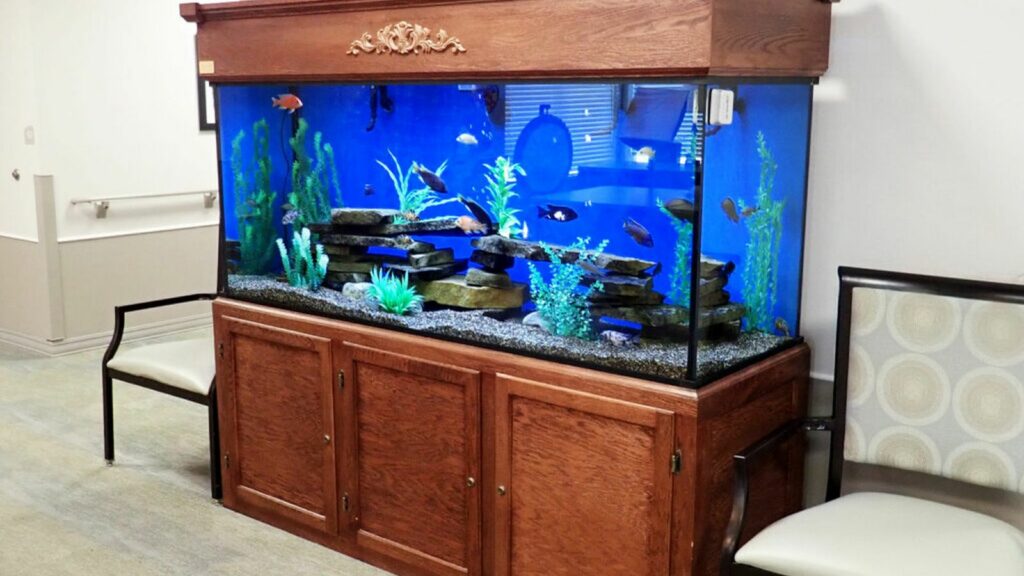Estimated Read Time: 4 minutes
If you’re searching for an aquarium, the choice between a glass and acrylic fish tank plays a crucial role.
Glass and acrylic have unique advantages and disadvantages, so the best material for you may vary depending on the situation.
In this brief post, we’ll explore 5 key differences between these tanks and give a short description of each.

Glass vs Acrylic Fish Tanks:
- Material Composition
- Weight
- Clarity
- Strength and Durability
- Customization
1. Material Composition
Glass Fish Tanks:
- Glass tanks are made from silica, which is a natural material.
- The manufacturing process involves melting silica sand at high temperatures and cooling it to form solid sheets.
- Glass tanks have been a traditional choice in the aquarium hobby due to their clarity and scratch-resistant properties.
Acrylic Fish Tanks:
- Acrylic tanks are constructed from a type of plastic known as polymethyl methacrylate (PMMA).
- Acrylic is manufactured by chemically bonding acrylic monomers, resulting in a lightweight and durable material.
- Acrylic tanks gained popularity for their lightweight design and optical clarity.
2. Weight
Glass Fish Tanks:
- Glass tanks are heavier than acrylic tanks, making them more challenging to move or transport.
- The weight can become a concern, especially for larger setups that require additional support and sturdy stands.
Acrylic Fish Tanks:
- Acrylic tanks are significantly lighter than glass tanks of the same size, making them easier to handle and install.
- Their lightweight nature allows for more flexible placement options and reduces the risk of structural damage to floors or furniture.
3. Clarity
Glass Fish Tanks:
- Glass tanks provide superior optical clarity, giving viewers a distortion-free and true-to-life glimpse of the aquatic world inside.
- They are less prone to scratching, ensuring the view remains unblemished for years.
Acrylic Fish Tanks:
- Acrylic tanks are known for their exceptional transparency, offering a clear view of the underwater landscape.
- However, they are more susceptible to scratching, and over time, may develop fine lines that can impact the overall clarity.
4. Strength and Durability:
Glass Fish Tanks:
- Glass tanks are more robust and less prone to scratches than acrylic tanks.
- They’re also less likely to warp or yellow over time, providing a stable and long-lasting environment.
Acrylic Fish Tanks:
- Acrylic tanks are more impact-resistant than glass tanks, reducing the risk of cracks or shattering.
- However, acrylic is more susceptible to yellowing from UV light, which can affect the aesthetics of the tank.
5. Customization:
Glass Fish Tanks:
- Glass tanks offer limited customization options, with standard rectangular or cuboid shapes being the most common.
- Custom-built glass tanks are available, but they can be expensive and have longer lead times.
Acrylic Fish Tanks:
- Acrylic tanks are highly customizable and easier to mold into various shapes and sizes.
- They are an excellent choice for creatively designed aquariums.
Conclusion: Glass vs Acrylic for Fish Tanks
If you prioritize optical clarity, scratch resistance, and a traditional aesthetic, glass tanks may be right for you.
On the other hand, if you seek lightweight, impact-resistant, and more customizable options, consider an acrylic tank.
Ultimately, the decision between glass and acrylic fish tanks will depend on your personal preferences, budget, and the specific needs of your fish.
Each of our Serenity Aquariums has a glass tank, but which material do you think is best?